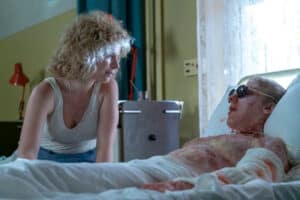Due to the success of the Chernobyl series, produced by HBO, the subject gained strength in the media and the CBR, as the main source of information for journalists when the subject involves Radiology, was sought by the SAÚDE magazine portal to talk about the subject.
The College's Director of Communications, Dr. Hilton Muniz Leão Filho, and physicist Simone Kodlulovich, both from the CBR Radiological Protection Commission, gave an interview to the vehicle.
Read in full: https://saude.abril.com.br/blog/saude-e-pop/chernobyl-e-os-riscos-da-radiacao-a-saude-e-ao-planeta/
Chernobyl and the risks of radiation to health and the planet
HBO channel miniseries recovers the story of the greatest nuclear tragedy of the 20th century and reopens the discussion on the dangers of radiation for humanity
On May 1, 1986, Labor Day holiday, Pripyat, in northern Ukraine, would get its first amusement park. Founded in February 1970, the city housed employees of the Chernobyl Nuclear Power Plant, located just 3 kilometers away. The children of Pripyat, however, never got a chance to ride a carousel or ride a Ferris wheel. Five days earlier, in the early hours of April 26, what was supposed to be a routine test at the plant's number 4 reactor turned into a nuclear accident. The worst in history.
On the afternoon of April 27, all 48,000 inhabitants of Pripyat had just 40 minutes to collect their belongings and leave their homes. They never came back. In 2000, the Chernobyl plant was closed and, two years later, released for visitation. Every year, an average of 60,000 tourists visit what's left of Pripyat. From a bedroom town, it became a ghost town.
After the premiere of Chernobyl, an HBO miniseries created by Craig Mazin based on the book Midnight in Chernobyl, by journalist Adam Higginbotham, owners of tourism agencies operating in the region estimate an increase of 40% in the number of visitors to the so-called “Exclusion Zone”, the name given to the area of 2,600 square kilometers isolated after the tragedy. Prices vary from 81 dollars, the day tour, to 110, including lunch, per person. In general, agencies provide a dosimeter – a device that measures radiation – for each client.
But is it safe to visit the place where a nuclear accident took place? Does ionizing radiation, the kind that harms living organisms, not harm visitors? Juliano Cerci, president of the Brazilian Society of Nuclear Medicine (SBMN), guarantees that, as long as the guidelines of the guides are respected, the tour is not harmful to health.
“Chernobyl, in Ukraine, and Fukushima, in Japan, are monitored with a very high degree of precision. In the case of Chernobyl, the areas where tourists can circulate are absolutely safe”, says the nuclear doctor and radiologist. “In authorized areas, radiation levels are within limits. Therefore, there is no risk to visitors”, agrees radiologist Hilton Muniz Leão Filho, from the Radiological Protection Commission of the Brazilian College of Radiology and Image Diagnosis (CRB).
The rules for visiting Chernobyl are clear: do not touch or lean against anything in the streets (poles and walls, for example), do not pick up objects from the ground (the level of soil contamination tends to be high), do not enter buildings abandoned (the risk of collapse is great), not interacting with animals (also due to the risk of contamination) and not eating or drinking outdoors. Disobeying some of these recommendations, in addition to bringing health risks, may result in a fine or arrest.
Technical glitch or human error?
To this day, it is not known for sure what caused the Chernobyl tragedy. Some say it was a reactor failure. Some argue that it was human error. A third group guarantees that it was a bit of both. There is also no consensus on the total number of deaths. The numbers range from 31, according to official Soviet government data, to 200,000, according to Greenpeace's estimate.
What is known is that, in general terms, the effects of radiation on the human body can be divided into acute and chronic.
The acute ones are immediate, appear in cases of direct or excessive exposure and are related to lesions on the skin (burns), digestive system or respiratory system. “They result from inhalation, ingestion of water, meat or vegetables exposed to radiation or direct contact with the skin”, explains Muniz. “The closer to the exposure site, the faster and more devastating the effects are”, he adds.
Chronic damage, on the other hand, is late, can manifest up to ten years after indirect exposure and is related to the appearance of tumors (thyroid cancer is the most common), genetic mutations and loss of fertility.
The severity of the injuries, explain the doctors, depends on a series of factors: the dose of radiation, the time of exposure and the part of the body affected. “Some areas are more susceptible, such as the lens of the eye, the thyroid, the region of the gonads and the mammary glands”, exemplifies physicist Simone Kodlulovich, from the National Nuclear Energy Commission (CNEN).
The radioactive cloud that the wind helped to spread – the first country to detect a worrying increase in radiation levels was Sweden, 1 100 kilometers away from Ukraine! – didn’t just harm humans. The environment has also been hit hard. Within a radius of 400 kilometers, the radiation contaminated rivers, lakes and forests and affected the reproduction of animals. Within a radius of 800 kilometers, herds of cattle showed a drop in milk production.
It is not all and any radiation, ponders Cerci, that is harmful to health. In small doses, exposure to radiation poses no risk. On the contrary: used in imaging tests and therapeutic devices, it helps diagnose diseases (as in mammography) and treat tumors (see radiotherapy).
“We have to be careful with radiation, yes, but it is necessary that precaution does not give way to fear. There are cases of patients who refuse to undergo certain procedures for fear of radiation. It is important to clarify that radiotherapy treats people with cancer through radiation and, in most cases, achieves excellent results. Any generalization can be dangerous”, warns the president of SBMN.
Photo: Disclosure/ HBO/HEALTH is Vital)




